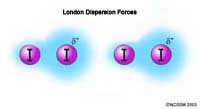How do molecular compounds bond?
1 Answer
Molecular or covalent compounds bond to each other by intermolecular forces of attraction.
These forces involve electrostatic attractions between the negative and positive charges in neighbouring particles.
DIPOLE-DIPOLE FORCES
Dipole-dipole forces are electrostatic attractions between the positive and negative ends of polar molecules.
These interactions tend to align the molecules and increase the attraction between them.

Polar molecules have a net attraction between them. Hydrogen chloride (HCl) and chloroform (CHCl₃) are examples of polar molecules.
Hydrogen bonds are an exceptionally strong type of dipole-dipole interaction. Do not confuse them with covalent bonds, such as C-H, O-H, N-H, or F-H bonds.
The simplest example of a hydrogen bond is found between water molecules.

LONDON DISPERSION FORCES
Consider the molecules of iodine. At any given instant, there may be a slightly greater electron density on one iodine atom than on the other.
This instantaneous dipole can induce a dipole in a neighbouring iodine molecule.
The induced dipole leads to an attractive force called a London Dispersion Force.

In order of decreasing strength, then, the intermolecular attractive forces among molecular compounds are
- Hydrogen bonds
- Dipole-dipole forces
- London dispersion forces


